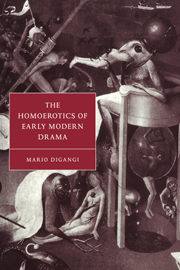Book contents
- Frontmatter
- Contents
- Preface
- 1 Introduction
- 2 The homoerotics of marriage in Ovidian comedy
- 3 The homoerotics of mastery in satiric comedy
- 4 The homoerotics of favoritism in tragedy
- 5 The homoerotics of masculinity in tragicomedy
- Notes
- Bibliography
- Index
- Cambridge Studies in Renaissance Literature and Culture
2 - The homoerotics of marriage in Ovidian comedy
Published online by Cambridge University Press: 02 December 2009
- Frontmatter
- Contents
- Preface
- 1 Introduction
- 2 The homoerotics of marriage in Ovidian comedy
- 3 The homoerotics of mastery in satiric comedy
- 4 The homoerotics of favoritism in tragedy
- 5 The homoerotics of masculinity in tragicomedy
- Notes
- Bibliography
- Index
- Cambridge Studies in Renaissance Literature and Culture
Summary
Queering the family
Is there anything queer about the family in early modern England? Until the mid 1980s, scholarship on early modern marriage and domestic life proceeded as if homoerotic desire were largely irrelevant to its concerns. A significant example of this tendency is Lawrence Stone's influential The Family, Sex and Marriage in England 1500–1800, which, despite its monumental scope, has very little to say about the relation of homosexuality to the family, sex, or marriage throughout 300 years of English history. As gay, lesbian, feminist, and queer scholarship has demonstrated with increasing subtlety and cumulative force, however, to ignore the place of same-sex desire or nonreproductive sexuality in early modern domestic life is not to provide an historically accurate portrait of Renaissance social structures. It is to project back onto the Renaissance particularly modern biases and ideologies, especially the notion that there are two distinct sexualities, heterosexuality and homosexuality, and that only the former has anything to do with the constitution and production of families.
Given the centrality of Shakespeare to Renaissance studies and his dominant reputation as the dramatist of romantic married love, queer scholarship on the family in early modern England faces a double task. One, it must insist on the homoerotic dimensions of courtship, marriage, and domestic experience inside the Shakespearean canon. Two, it must also look outside the canon to less familiar, even obscure texts that depict the homoerotic dimensions of these institutions and experiences more explicitly, or, at least, differently from Shakespeare's.
- Type
- Chapter
- Information
- The Homoerotics of Early Modern Drama , pp. 29 - 63Publisher: Cambridge University PressPrint publication year: 1997



